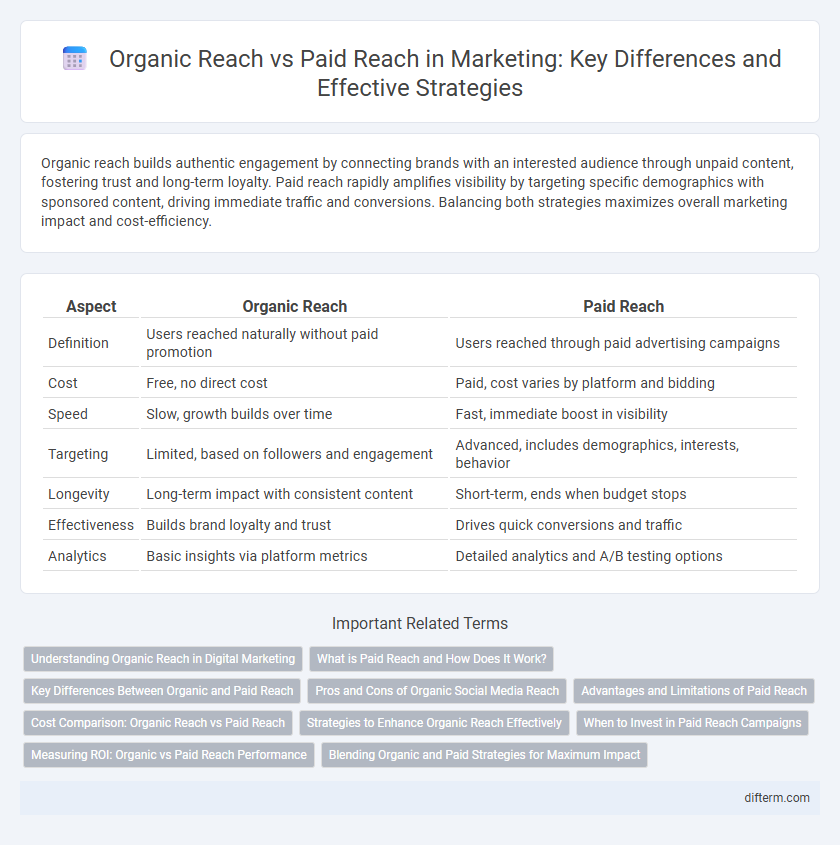Organic reach builds authentic engagement by connecting brands with an interested audience through unpaid content, fostering trust and long-term loyalty. Paid reach rapidly amplifies visibility by targeting specific demographics with sponsored content, driving immediate traffic and conversions. Balancing both strategies maximizes overall marketing impact and cost-efficiency.
Table of Comparison
| Aspect | Organic Reach | Paid Reach |
|---|---|---|
| Definition | Users reached naturally without paid promotion | Users reached through paid advertising campaigns |
| Cost | Free, no direct cost | Paid, cost varies by platform and bidding |
| Speed | Slow, growth builds over time | Fast, immediate boost in visibility |
| Targeting | Limited, based on followers and engagement | Advanced, includes demographics, interests, behavior |
| Longevity | Long-term impact with consistent content | Short-term, ends when budget stops |
| Effectiveness | Builds brand loyalty and trust | Drives quick conversions and traffic |
| Analytics | Basic insights via platform metrics | Detailed analytics and A/B testing options |
Understanding Organic Reach in Digital Marketing
Organic reach in digital marketing refers to the number of unique users who view content without paid promotion, relying on algorithms, SEO, and user engagement. Understanding organic reach is crucial for building authentic connections, enhancing brand credibility, and optimizing content strategies to increase visibility naturally. Metrics such as impressions, engagement rates, and audience demographics help marketers evaluate the effectiveness of organic reach campaigns.
What is Paid Reach and How Does It Work?
Paid reach refers to the number of users who see your content as a result of paid advertising efforts on platforms like Facebook, Instagram, or Google Ads. It works by targeting specific demographics, interests, and behaviors through ad campaigns, ensuring your message reaches a highly relevant audience beyond your organic followers. Paid reach amplifies visibility by leveraging platform algorithms that prioritize sponsored content based on budget and targeting parameters.
Key Differences Between Organic and Paid Reach
Organic reach depends on the natural engagement and algorithmic visibility of content without direct payment, resulting in slower but more authentic audience growth. Paid reach allows marketers to target specific demographics with precision, boosting visibility quickly through ads but often at a higher cost per engagement. Key differences include control over audience targeting, speed of exposure, and overall impact on brand trust and credibility.
Pros and Cons of Organic Social Media Reach
Organic social media reach builds authentic engagement by connecting directly with followers without advertising costs, fostering brand loyalty and trust. However, it often results in limited visibility due to algorithm restrictions and requires consistent, high-quality content to maintain growth. Marketers benefit from organic reach through cost-efficiency but face challenges in scalability and slower audience expansion compared to paid reach.
Advantages and Limitations of Paid Reach
Paid reach in marketing offers precise audience targeting, allowing brands to tailor campaigns to specific demographics, locations, and interests, which significantly boosts visibility and conversion rates. Its main limitation is the ongoing cost, which can be substantial for sustained campaigns and may lead to diminishing returns if ads are not continuously optimized. Paid reach also risks ad fatigue, where users become desensitized to repetitive ads, potentially reducing engagement over time.
Cost Comparison: Organic Reach vs Paid Reach
Organic reach requires minimal financial investment, leveraging content quality and audience engagement to naturally grow visibility over time. Paid reach incurs direct costs through advertising budgets but delivers immediate, scalable exposure targeting specific demographics. Cost efficiency often depends on campaign goals; organic reach excels in long-term brand building, while paid reach offers rapid results with measurable ROI.
Strategies to Enhance Organic Reach Effectively
Maximizing organic reach involves creating high-quality, engaging content tailored to the target audience's preferences and utilizing SEO best practices to improve visibility on social media and search engines. Leveraging user-generated content, fostering community interaction through comments and shares, and consistently posting during peak engagement times strengthens organic presence without incurring advertising costs. Employing data analytics tools to monitor audience behavior and content performance enables marketers to refine strategies and boost organic reach effectively over time.
When to Invest in Paid Reach Campaigns
Invest in paid reach campaigns when organic reach plateaus despite consistent content quality and audience engagement metrics indicate limited growth potential. Target paid reach to amplify content during product launches, seasonal promotions, or specific audience segments that require precise targeting for higher conversion rates. Allocate budget strategically by analyzing cost-per-click (CPC) and return on ad spend (ROAS) metrics to ensure paid campaigns complement organic efforts without overspending.
Measuring ROI: Organic vs Paid Reach Performance
Measuring ROI in marketing requires a clear comparison between organic and paid reach performance. Organic reach offers long-term engagement with minimal cost, but paid reach delivers immediate, targeted exposure, making ROI calculation dependent on campaign goals and budget. Analyzing metrics such as conversion rates, cost per acquisition (CPA), and customer lifetime value (CLV) helps determine which approach yields better returns for specific marketing objectives.
Blending Organic and Paid Strategies for Maximum Impact
Blending organic and paid reach strategies enhances marketing effectiveness by leveraging the authentic engagement of organic content alongside the precise targeting capabilities of paid campaigns. Organic strategies build trust and long-term audience loyalty through consistent, valuable content, while paid reach accelerates visibility and drives immediate traffic with tailored ads. Integrating both approaches enables marketers to optimize budget allocation, increase brand awareness, and maximize overall return on investment.
Organic reach vs paid reach Infographic

 difterm.com
difterm.com